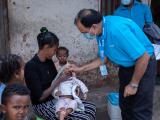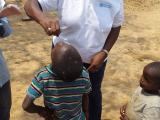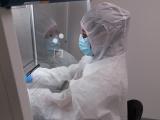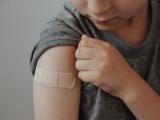Oct 16, 2008 (CIDRAP News) – Teams of researchers from several countries today report positive results in the long battle to eradicate polio. At the same time, they acknowledge that the international campaign faces an extraordinary challenge of both biology and economics: While circulation of wild poliovirus may cease, polio vaccination may need to continue for an indefinite period of time.
Writing in the New England Journal of Medicine, researchers from Imperial College London, the World Health Organization (WHO), and the National Primary Health Care Development Agency of Nigeria say that an oral vaccine containing a single strain of poliovirus produces four times greater immunity in children than the long-used three-strain vaccine does. Separately, a multinational team led by experts from the Egyptian government, two Egyptian universities, and a Cairo hospital say that the single-strain or monovalent oral vaccine not only produces superior immunity but also reduces the likelihood that recipients will shed vaccine virus after being dosed.
Those two findings are good news for the WHO, which pushed for development of a monovalent vaccine and considers its deployment since 2005 a key element in the eradication struggle. But an accompanying editorial says these results represent only limited gains—because in order to finish the job of eradication and protect against its aftereffects, the campaign must abandon the oral vaccine and begin using the much more expensive injectable version.
"Poliovirus will not go away after circulation of wild-type virus is halted, and a high level of immunity in the global population must be maintained—and not just in high-income countries that have already switched to the safer but more expensive" injectable vaccine, Ellie Ehrenfeld, PhD, of the National Institutes of Health, and Konstantin Chumakov, PhD, of the Food and Drug Administration say in the editorial.
A difficult endgame
Their piece marks one of the most public statements yet of the difficult endgame of the 20-year-old campaign, which was conceived in the enthusiasm that followed the 1977 eradication of smallpox.
The campaign, formally called the Global Polio Eradication Initiative, is a joint project of the WHO, the US Centers for Disease Control and Prevention (CDC), UNICEF, and the service organization Rotary International. It began by hoping to eradicate polio by 2000, a goal that was later pushed back to 2005 and now has no firm date.
The campaign uses oral polio vaccine (OPV), which is made of attenuated live poliovirus that reproduces in the gut of children who receive it and passes to close contacts in a form of passive immunization.
It has not reached its eradication target largely because of the persistence of the disease in four countries. Polio continues to circulate in two Indian provinces because the vaccine virus does not attach to the gut well when it has to compete with other enteric viruses and when children have frequent diarrheal disease. It persists in Afghanistan and Pakistan because conflict has kept vaccinators out of key areas; in September, two doctors and their driver were killed by a suicide bomber in Kandahar. And it remains in Nigeria thanks to political interference that halted vaccination completely in 2003—permitting a resurgence that re-infected a number of other countries—and that still suppresses vaccine acceptance among families in some areas.
So far this year, there have been 1,341 cases of polio in 16 countries, compared with 1,315 cases in 12 countries in all of 2007. But cases in India are almost half of what they were last year, due in part to the use of the monovalent vaccine described in today's reports, which say that the environmental factors present in India do not interfere with vaccine efficacy elsewhere.
The oral vaccines are inexpensive, costing about 12 cents per dose, and simple to administer. But they are not foolproof. In one out of every few million recipients, they cause polio paralysis. Immune-impaired individuals can become long-term shedders of the virus. And the viral replication that enables passive immunization can go awry and allow the weakened strain to mutate and regain its virulence, a process that caused outbreaks of vaccine-derived poliovirus in Hispaniola in 2000 and Nigeria since 2005.
Injectable vaccine safer, more costly
None of those threats exist with the injectable vaccine, which is based on a killed virus and is already used in much of the industrialized world. But that vaccine, known as IPV, is also much more expensive (at least $2.70 per dose), must be administered by healthcare workers, and poses an additional problem of needle disposal.
Over the past year, starting with an NIH summit co-chaired by Ehrenfeld, the global public health community has been exploring whether, and for how long, IPV must be used after circulation of wild poliovirus is interrupted. IPV would protect against reverted virus from long-term shedders or in the environment. It would also provide immunity if any forgotten poliovirus samples in lab freezers worldwide were to be released, or if a containment failure allowed the virulent strain on which the vaccine is based to escape from a manufacturing plant.
"If you want to maintain immunity against polio in the post-eradication era, the only vaccine to do it with is IPV, routinely," Oliver Rosenbauer, a WHO spokesman, said in an interview.
As part of endgame planning, he said, the initiative may recommend that any country where polio vaccine is manufactured—including not just the United States, but France, Belgium, India, and others—adopt routine IPV use. Countries concerned about re-importation of polio might also want to use IPV. To make that possible, he said, WHO is promoting a research agenda that will explore making IPV more cheaply, making it from a less-virulent seed strain, and administering it in forms that would not require subcutaneous injection.
If polio vaccination continues after eradication, it will foil one of the goals of the eradication campaign: ending vaccination's significant annual cost. For example, the United States has saved an estimated $17 billion because it no longer conducts routine smallpox vaccination of civilians.
And IPV might impose additional costs beyond the obvious, because more doses of vaccine are likely to be necessary. With the oral vaccines, vaccinators can immunize one or two family members and be confident the immunity will spread to close contacts; with IPV, everyone who wishes to be immune must receive a shot.
The likelihood that vaccination will continue after eradication is viewed with bemusement by a set of scientists who have maintained for years that tight polio control—via continued vaccination—is more achievable than eradication. In their view, the global campaign is now describing what they have long suggested—only with a more expensive vaccine than they had prescribed.
Fresh research on how best to proceed in the endgame is essential, said Dr. D.A. Henderson, the leader of the smallpox eradication program, who has said for years that polio eradication might not be achievable. "If I am the head of a country, and I am faced with spending much more money on IPV, or continuing to use OPV and taking my chances on vaccine-derived viruses, my conclusion is probably simple," he said. "We need to have much better data on the risk vaccine-derived viruses represent."
El-Sayed N, El-Gamal Y, Abbassy A, et al. Monovalent type 1 oral poliovirus vaccine in newborns.N Engl J Med 2008 Oct 16;359(16):1655-65 [Full text]
Jenkins HE, Aylward RB, Gasasira A, et al. Effectiveness of immunization against paralytic poliomyelitis in Nigeria.N Engl J Med 2008 Oct 16;359(16):1666-74 [Full text]
Ehrenfeld E, Chumakov K. Monovalent oral poliovirus vaccines—a good tool but not a total solution. (Editorial) N Engl J Med 2008 Oct 16;359(16):1726-7 [Full text]
See also:
Current polio case count
http://www.polioeradication.org/Dataandmonitoring/Poliothisweek.aspx
Ehrenfeld E, Glass RI, Agol VI, et al. Immunisation against poliomyelitis: moving forward. (Commentary) Lancet 2008 Apr 19;371(9621):1385-7 [Access to full text requires subscription or payment]
http://www.thelancet.com/journals/lancet/article/PIIS0140673608605978/abstract
















